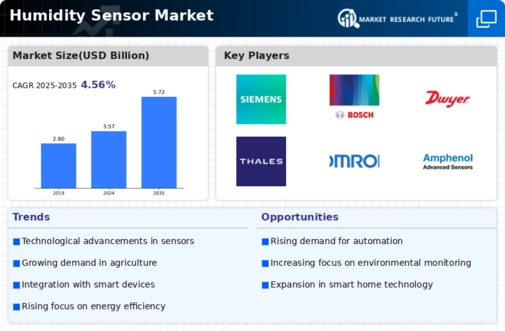Top Industry Leaders in the Humidity Sensor Market

*Disclaimer: List of key companies in no particular order
Competitive Landscape of Humidity Sensor Market:
The global humidity sensor market is experiencing robust growth, propelled by expanding applications across diverse industries. From ensuring optimal comfort in buildings to maintaining precise humidity levels in critical industrial processes, these sensors are becoming ubiquitous. Navigating this dynamic landscape requires a keen understanding of the competitive forces at play.
Some of the Humidity Sensor companies listed below:
- Honeywell International
- Sensirion AG
- GE Inspection Technologies
- PCE Holdings GmbH
- Amphenol Corporation
- Texas Instruments
- Bosch Sensortec GmbH
- OMRON Corporation
- Silicon Laboratories
- TDK Corporation
- Alps Alpine co
- STMicroelectronics NV
Market Share Analysis:
Analyzing market share in the humidity sensor market necessitates considering several crucial factors:
- Technology Segmentation: Market players predominantly compete based on the sensor technology utilized, such as capacitive, resistive, polymer, and infrared. Each technology holds unique advantages and caters to specific applications. Monitoring market share within each technology segment offers valuable insights.
- Industry Vertical Focus: The market caters to a diverse range of industries, including automotive, consumer electronics, HVAC, agriculture, healthcare, and food & beverage. Companies vying for dominance often specialize in servicing specific industry needs, tailoring their offerings accordingly. Tracking market share within individual verticals unveils targeted competitors and potential growth opportunities.
- Geographical Distribution: The market exhibits variations in growth and competition across different regions. Asia-Pacific, driven by rapid industrialization and urbanization, is currently the largest market. However, Europe and North America remain significant players, each with established giants and emerging innovators. Analyzing regional market share distribution identifies dominant players in specific geographies and pinpoints promising emerging markets.
- Brand Recognition and Reputation: Established brands with strong track records and a loyal customer base often hold a significant market share advantage. However, smaller companies focused on niche applications or offering specialized services can carve out their own spaces. Monitoring brand mentions, customer reviews, and industry awards can shed light on market perception and competitive positioning.
Strategies Adopted by Key Players:
Companies within the humidity sensor market employ various strategies to secure a competitive edge:
- Innovation and Product Differentiation: Constant R&D efforts result in new and improved sensor technologies. Miniaturization, enhanced accuracy, lower power consumption, and integration with IoT platforms are key areas of focus. Companies that consistently launch innovative products attract new customers and retain existing ones.
- Strategic Partnerships and Acquisitions: Collaborations with complementary players across the value chain, such as chipmakers, device manufacturers, and system integrators, can accelerate market reach and expertise. Acquisitions are another route to gain access to new technologies, expand product portfolios, and enter new markets.
- Cost Optimization and Scalability: Efficient production processes, robust supply chains, and cost-effective materials play a crucial role in maintaining a competitive edge. Companies with strong operational capabilities can offer cost-competitive solutions without compromising quality, gaining an edge in price-sensitive segments.
- Marketing and Brand Building: Building brand awareness through targeted marketing campaigns, showcasing expertise through technical seminars and conferences, and establishing strong customer relationships are vital for gaining market share.
New and Emerging Companies:
The humidity sensor market is witnessing the emergence of innovative startups alongside established players:
- SensorTech Solutions: This Israeli company specializes in miniaturized, low-power humidity sensors ideal for wearable devices and IoT applications.
- Hummingbird Sensors: This US-based startup focuses on developing novel hydrogel-based sensors for agricultural and environmental monitoring.
- SensiFab: This German company offers customized, 3D-printed humidity sensors for niche industrial applications.
Latest Company Updates:
Sep 2023- With the help of Honeywell's leading materials and energy systems knowledge and ESS's unique IFB design, Honeywell and ESS are working together to advance further the creation of iron flow battery (IFB) energy storage systems. Through their partnership, ESS receives a license to use Honeywell's flow battery intellectual property, and Honeywell is allowed to include ESS technology in its global offering. The two also intend to collaborate on ongoing technological improvement, IFB system packaging, and cost reduction. The recommended design life of an ESS battery system is 25 years, but with appropriate maintenance, the battery modules, electrolytes, tubing, and other components may live for decades longer. For instance, it is anticipated that the battery will not deteriorate at all after 20,000 cycles. $27.5 million has been contributed by Honeywell to ESS. Together, Honeywell and ESS are leveraging the rapid expansion of long-duration energy storage.
Apr 2023- For an undisclosed purchase amount, MEMS micro speaker company Arioso Systems GmbH (Dresden, Germany) will be acquired by sensor manufacturer Bosch Sensortec GmbH. Arioso Systems GmbH, a Fraunhofer IPMS spin-off, has successfully concluded its first round of funding to introduce a cutting-edge silicon-based sound transducer. The audio transducer from Arioso Systems produces sound utilizing the movement of silicon chip lamellas oriented vertically. Arioso Systems' technique employs the chip volume instead of the surface, which is different from the typical membrane. Thus, a small MEMS micro-speaker with an active area of 10 square millimeters can produce sound pressure levels of up to 120 dB. The low capacitance and electrostatic actuator of the all-silicon MEMS make Arioso Systems technology energy efficient, enabling the sensor to prolong battery life in other wearables and hearables like TWS.
